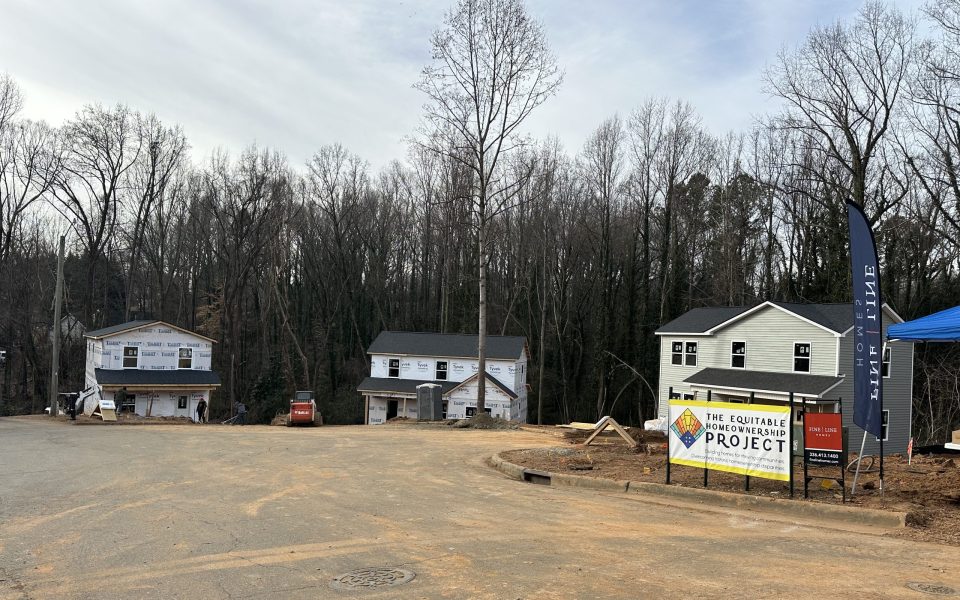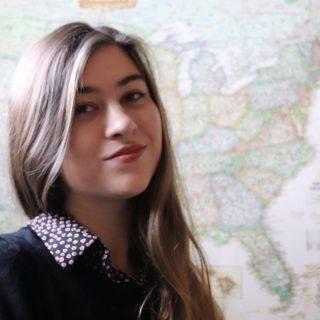Featured photograph: Some of the Equitable Homeownership Project’s “mission-driven housing.” (Photograph by Gale Melcher)
The city of Winston-Salem owns a lot of empty lots.
And in order to get that vacant land into the hands of developers interested in building affordable housing, they’re selling parcels for $1 apiece.
In late January, Winston-Salem plunged into 23 degree weather.
Huddling in the biting cold on the morning of Jan. 23, city staff, contractors and clergy came together on a corner of property in the Southwest Ward formerly owned by the city. Now it’s owned by the Moravian Church, which has taken on the task of building four affordable homes there. It’s part of the Equitable Homeownership Project, an initiative bringing together the church, local leaders, government agencies and nonprofits to build new, affordable housing for first-time homebuyers making less than 80 percent annual median income.
In Winston-Salem, the median household income is $54,416 according to census data.
How did this come together?
When the church originally came to the council with their request, they asked for 19 lots. Due to their lack of experience in constructing housing, they were given four. In June 2024, city leaders unanimously agreed to sell the land to the church, handing them $160,000 in ARPA funding assistance.
These parcels of land are some of the last $1 lots in the Southwest Ward — the only remaining plot is located across the street at 1542 Sunbridge Court.
The team made headway quickly — the Southwest Ward’s councilmember Scott Andree-Bowen told TCB that the homes look drastically different now from when he visited them in mid-December, when they were “just wood.”
On Jan. 23, a Bobcat tractor growled across the terrain, kicking up dust and gravel. Remnants of ochre dust had settled into the concrete and skeletal trees rose over the four houses, which stood stalwart in various states of completion.
The two-story, 1,500-square-foot homes come with three bedrooms and 2.5 baths, and are valued between $280,000 and $300,000. But their price will be capped at $194,500.
If the homeowners want to tack on an extra living space — an accessory dwelling unit, or an ADU — they can, thus helping them increase the value of their home. In 2022, to encourage more affordable housing, city leaders changed their guidelines for ADUs and no longer require people to seek permission from the city council in order to build an extra unit. Residents just need to meet certain conditions and get approval from city zoning staff.
This is just the first set of new homes for the Equitable Homeownership Project; they recently submitted a proposal to the city in the hopes of building 10 homes. The city still has dozens of vacant lots available, mostly on the east side of the city.
With this project, the homes are built in an area that’s close to grocery stores, schools and places to worship, and has access to sidewalks and bus lines.
What’s the mission?
According to Neil Routh, president of the Provincial Elders Conference of the Moravian Church, the Equitable Homeownership Project is about “restoring” what Moravians have “broken.” These homes are ways for the church to make amends for past harm.
Starting in 1753, the Moravians wove a thick thread through the city’s tapestry, settling and constructing dozens of new buildings within their first 20 years on the soil. But in addition to owning slaves, the Moravians “were silent” when Black communities were bulldozed to make way for highways and “improvement,” Routh said.
Now working to rectify those past mistakes, the church is partnering with Piedmont Federal Bank to offer affordable loans to families.
“Not one single dollar” will come back to the Moravian Church, according to Routh.
“It’s a project to help homeowners stand on their own, and stand in a bond of friendship with this whole community,” he said.
Rev. Russell May with the Moravian Church and Anthony’s Plot Community, a ministry serving the city’s Sunnyside District, is another leader with the Equitable Homeownership Project.
The goal is to create “mission-driven housing,” not market-driven housing, May said.
When a family can’t own their home, that’s a loss to the community, he explained. And children can become stressed when they have to move around a lot.
“You have these family stresses that come out of this trauma of this housing crisis,” he added.
Allonda Hawkins, a real estate professional with the Hawkins Group, said that over the years, she’s grown frustrated with the lack of affordable housing in the area.
When a 2018 study found that the city was facing a shortage of more than 16,000 affordable and low-income units, city leaders vowed to add 750 new units each year.
She’s working alongside families on this project, not just to help them find a home, but to help build trust, too. To that end, the project has worked to listen to people’s life stories and look at their financial records to give a chance to those who might have been passed over for a home in the past.
“The families who are going to move into any of the homes we sell are already some of the most resilient, savvy and incredible people in our community,” May said. “They have made things work and made a way where there was no way.”
They might be struggling, but when you change one thing — homeownership — May said, it “unlocks” opportunities and changes the trajectory for that family.
“Far too often, people in our communities are overlooked,” Hawkins added. “Not because they lacked the desire to own their own home, not because they lacked the ability to skip out on a Starbucks or avocado toast, but because the system wasn’t built to support them.”
Winston-Salem’s landscape was designed in part by racial covenants — deed restrictions that prevented people of color from buying certain property, and that has led to inequities in generational wealth. Block-by-block segregation and racist ordinances imposed by city leaders in the early 1900s dictated where families were allowed to live. In the 1950s, urban renewal projects pushed aside the homes of Black people to make way for Highway 52 and Business 40. Today, most of the wealthy census tracts are on the west side of the city while the poorest are to the east.
According to 2021 census data, white householders have 10 times more wealth than Black householders.
This project provides a “direct material means to begin to shrink that racial wealth gap,” local activist and pastor Paul Robeson Ford said, and gives people a chance to start building generational wealth.
“The desire to help heal the hearts of those who have been unfairly targeted is just mind-blowing,” Hawkins said.
All CityBeat reporting content is made possible by a grant from the NC Local News Lab Fund, available to republish for free by any news outlet who cares to use it. Learn More ↗
Republish this storyJoin the First Amendment Society, a membership that goes directly to funding TCB‘s newsroom.
We believe that reporting can save the world.
The TCB First Amendment Society recognizes the vital role of a free, unfettered press with a bundling of local experiences designed to build community, and unique engagements with our newsroom that will help you understand, and shape, local journalism’s critical role in uplifting the people in our cities.
All revenue goes directly into the newsroom as reporters’ salaries and freelance commissions.


Leave a Reply